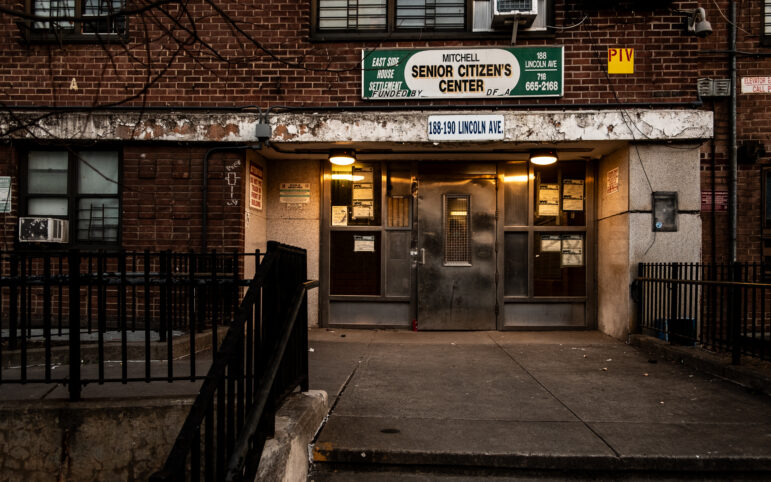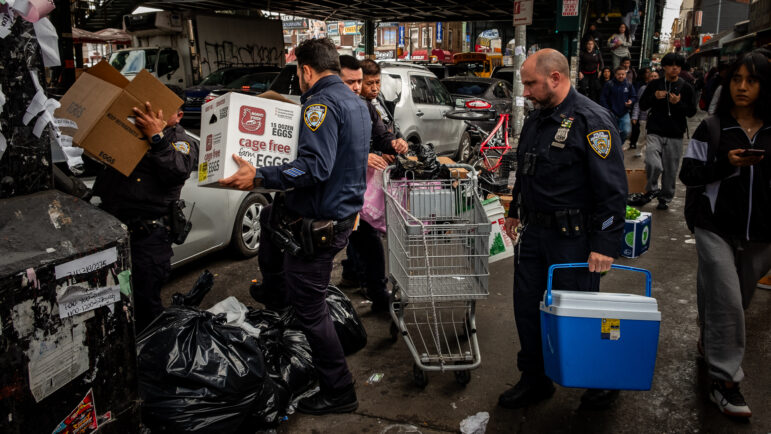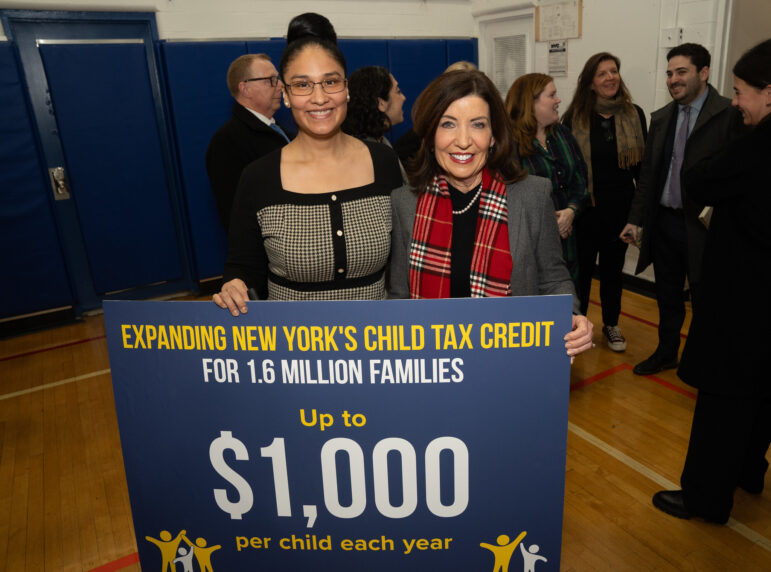
Adi Talwar
The PATH building in the south Bronx, where families go to apply for shelter in the DHS system, only one of several places homeless New Yorkers can end up.
Are more people homeless in New York City than ever before?
For many weeks the New York Post and other media have been running stories about people experiencing homelessness in the city, using increased homelessness as a measure of declining “quality of life” in New York City. They’ve featured stories about public urination, bathing in the fountain at Columbus Circle, people sleeping all over the sidewalks, aggressive panhandling, disruptions of commerce and leisure activities and encampments of homeless people in Tompkins Square Park and other public places.
One city police union, the Sargent’s Benevolent Association, asked police officers and their families and friends to snap pictures of homeless New Yorkers sleeping on the streets and post the photos of these people in distress to a Flickr account in their “Peek-A-Boo, I See You” campaign.
While all the unwanted publicity was terrifically stigmatizing, potentially it focused attention on the scourge of homelessness – at least until Flickr took the site down as inappropriate. But it all begs the question: Is homelessness increasing? The answer is surprisingly complicated.
Often in covering matters of public policy the media latches on to a single statistic to portray what’s going on. It might be the murder rate as a metaphor for violent crime, the Dow Jones Industrial Average as a measure of the stock market or monthly unemployment figures as gauge of the economy’s health. With homelessness in New York City it’s the Department of Homeless Services (DHS) daily shelter census, a precise count of how many people sleep in city DHS homeless shelters each day. When you hear or read the number of homeless people in the city is 53,000, or up to 60,000, or down to 56,000 – the figure is really the DHS daily census. Though this is an exact figure for people in the largest city shelter system (the largest city shelter system in the United States), it doesn’t measure the number of homeless people in the city.
It doesn’t include shelter systems operated by other agencies. For example, the city’s Human Resources Administration (HRA) operates a domestic violence shelter system of about 2,228 beds not included in the figure. Neither is the city’s HIV-AIDS Services Administration (HASA) emergency shelter system which recently housed over 2,000 residents. It doesn’t include the 329 city funded beds for “Runaway-and-Homeless” youths, unaccompanied homeless minors in New York City. There are also faith based non-DHS shelters, not city funded and typically in churches or missions, often opening and closing depending on weather and availability of volunteers, which probably numbers in the hundreds of residents on any given night.
The DHS census for August 13, 2015, was 56,544, including 23,176 children under 18. But that doesn’t count those other shelter systems which would push the number higher, probably well over 61,000. And that still doesn’t include unsheltered people, homelessness on the streets.
New York City, and every community across the country, conducts a one-night “point-in-time” count of unsheltered homeless people. They do this by actually counting people on the street. In New York we call it the HOPE (Homeless Outreach Population Estimate) count, and recruit and train about 3,500 volunteers to conduct it. It’s typically done on the fourth Monday in January, but in 2015 it was postponed until February due to a blizzard forecast. The City’s HOPE Count is well done, including a system of volunteer “decoys” to determine how many people might be missed in the effort and factor that in to the final estimate. Nonetheless, any effort to count homeless people living on the streets is imperfect based on a number of challenges including people who don’t want to be found, the incredible scope of the undertaking and other issues. Most likely the estimate is an undercount, though the city does the best it can.
In 2015 the HOPE count estimated 3,182 unsheltered homeless people on the streets the February night of the count. The year before the estimate was 3,357. To the extent those figures were accurate, or approximately accurate, it represents a 5 percent decrease year over year. One certainty is that there are more unsheltered people in nicer weather than in the brutal city winter.
Complicating the question is the fact that there is no accepted standard definition of homelessness. We would all agree about people with no housing on the street or residing in a homeless shelter. But what about someone living as a squatter, sleeping in a van or on someone else’s couch as they wear out their welcome? The federal McKinney-Vento Act requires school districts to report the number of “unstably housed” students annually, under a definition that includes living temporarily in a motel or with others because they have no home of their own available. For the 2013-14 academic year New York City reported 87,210 unstably housed students in our public schools; far greater than the DHS shelter census ever recorded.
We do know the DHS shelter census was about 53,000 when the de Blasio administration took over in January of 2014. We know it increased to almost 60,000, including 25,000 children, in November and December of 2014. Then as new city policies creating rental subsidies and a NYCHA public housing priority to move people from shelter to stable housing took hold, fell back to the 56,000+ it’s at now, including about 23,000 children.
But the real question the Post, the police and the public is interested in is whether the unsheltered homeless population in New York City is increasing? The Mayor has cited the latest HOPE count figures to question if the number is increasing, or perhaps just the media focus is growing. At the same time Police Commissioner Bratton has publicly agreed the number is rising and promised greater “quality of life” issue enforcement.
When it comes to empirical data or documentable evidence, the truth is we don’t know for sure. A recent Quinnipiac poll said the majority of New Yorkers think there has been an increase. Everyone I ask thinks so too. Anecdotally, I agree.
If there are more people homeless on the streets of New York we can react in either of two ways. We can stigmatize the victims of homelessness, make life tougher for them, “move them along” from one neighborhood or park to another, and step-up enforcement of laws that criminalize homelessness and deep poverty. While this may provide a response to sensational news stories or community complaints, it’s very expensive, makes life much more difficult for the victims and offers absolutely no real solution.
Alternatively, the city has announced plans to dramatically increase availability of mental-health services and outreach efforts to street homeless people. We also know programs like providing rental subsidies and—especially—supportive housing that includes both subsidies and wrap-around supportive services are proven effective at providing better outcomes for the victims of homelessness and the neighborhoods involved. They also save public resources over time.
Faced with the choice of expensive responses that don’t solve homelessness (and in fact make the situation worse) or actual solutions that work and save money over time, the better public policy seems apparent. The better short-term political solution isn’t so obvious.
Jeff Foreman is Policy Director at New York City’s Care for the Homeless, and lives in Queens.









One thought on “Are There More Homeless People in New York City?”
the City refuses to release the Hope Count which shows decrease of street homeless in some areas and increase in other areas. This lack of transparency does not allow communities, nonprofits, agencies to plan realistically.